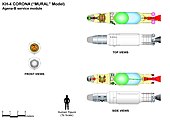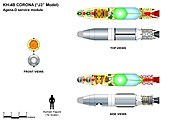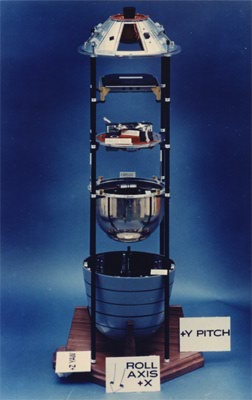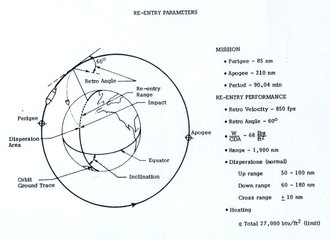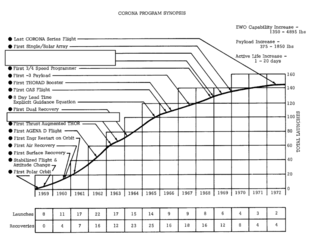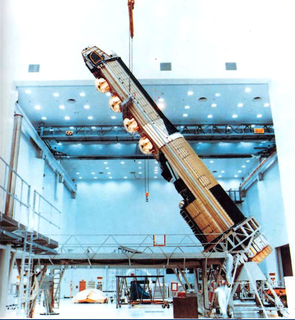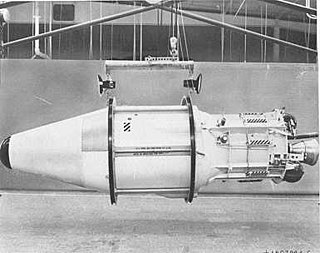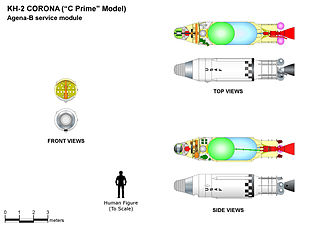| Mission No. | Cover Name | Launch Date | NSSDC ID No. | Alt. Name | Camera | Notes |
|---|
| R&D | Discoverer Zero [73] | 21 January 1959 | | 1959-F01 | none | Agena ullage/separation rockets ignited on the pad while the launch vehicle was being fueled prior to the intended flight. |
| R&D | Discoverer 1 | 28 February 1959 | 1959-002A | 1959 Beta 1 | none | Decay: 17 March 1959. [74] |
| R&D | Discoverer 2 | 13 April 1959 | 1959-003A | 1959 GAM | none | First three-axis stabilized satellite; capsule recovery failed. |
| R&D | Discoverer 3 | 3 June 1959 | DISCOV3 | 1959-F02 | none | Agena guidance failure. Vehicle fell into the Pacific Ocean |
| 9001 | Discoverer 4 | 25 June 1959 | DISC4 | 1959-U01 | KH-1 | Insufficient Agena engine thrust. Vehicle fell into the Pacific Ocean |
| 9002 | Discoverer 5 | 13 August 1959 | 1959-005A | 1959 EPS 1 | KH-1 | Mission failed. Power supply failure. No recovery. |
| 9003 | Discoverer 6 | 19 August 1959 | 1959-006A | 1959 ZET | KH-1 | Mission failed. Retro rockets malfunctioned negating recovery. |
| 9004 | Discoverer 7 | 7 November 1959 | 1959-010A | 1959 KAP | KH-1 | Mission failed. Satellite tumbled in orbit. |
| 9005 | Discoverer 8 | 20 November 1959 | 1959-011A | 1959 LAM | KH-1 | Mission failed. Eccentric orbit negating recovery. |
| 9006 | Discoverer 9 | 4 February 1960 | DiSC9 | 1960-F01 | KH-1 | Agena accidentally damaged during on-pad servicing. Premature cutoff and staging signal sent to Thor. |
| 9007 | Discoverer 10 | 19 February 1960 | DISC10 | 1960-F02 | KH-1 | Control failure followed by RSO destruct T+52 seconds after launch |
| 9008 | Discoverer 11 | 15 April 1960 | 1960-004A | 1960 DEL | KH-1 | Attitude control system malfunctioned. No film capsule recovery. |
| R&D | Discoverer 12 | 29 June 1960 | DISC12 | 1960-F08 | none | Agena attitude control malfunction. No orbit. |
| R&D | Discoverer 13 | 10 August 1960 | 1960-008A | 1960 THE | none | Tested capsule recovery system; first successful capture. |
| 9009 | Discoverer 14 | 18 August 1960 | 1960-010A | 1960 KAP | KH-1 | First successful recovery of IMINT from space. Cameras operated satisfactorily. |
| 9010 | Discoverer 15 | 13 September 1960 | 1960-012A | 1960 MU | KH-1 | Mission failed. Attained orbit successfully. Capsule sank prior to retrieval. |
| 9011 | Discoverer 16 | 26 October 1960 | 1960-F15 | 1960-F15 | KH-2 | Agena failed to separate from Thor. |
| 9012 | Discoverer 17 | 12 November 1960 | 1960-015A | 1960 OMI | KH-2 | Mission failed. Obtained orbit successfully. Film separated before any camera operation leaving only 1.7 ft (0.52 m) of film in capsule. |
| 9013 | Discoverer 18 | 7 December 1960 | 1960-018A | 1960 SIG | KH-2 | First successful mission employing KH-2 camera system. |
| RM-1 | Discoverer 19 | 20 December 1960 | 1960-019A | 1960 TAU | none | Test of Missile Defense Alarm System |
| 9014A | Discoverer 20 | 17 February 1961 | 1961-005A | 1961 EPS 1 | KH-5 | See KH-5 |
| RM-2 | Discoverer 21 | 18 February 1961 | 1961-006A | 1961 ZET | none | Test of restartable rocket engine |
| 9015 | Discoverer 22 | 30 March 1961 | DISC22 | 1961-F02 | KH-2 | Agena control malfunction. No orbit. |
| 9016A | Discoverer 23 | 8 April 1961 | 1961-011A | 1961 LAM 1 | KH-5 | See KH-5 |
| 9018A | Discoverer 24 | 8 June 1961 | DISC24 | 1961-F05 | KH-5 | See KH-5 |
| 9017 | Discoverer 25 | 16 June 1961 | 1961-014A | 1961 XI 1 | KH-2 | Capsule recovered from water on orbit 32. Streaks throughout film. |
| 9019 | Discoverer 26 | 7 July 1961 | 1961-016A | 1961 PI | KH-2 | Main camera malfunctioned on pass 22. |
| 9020A | Discoverer 27 | 21 July 1961 | DISC27 | 1961-F07 | KH-5 | See KH-5 |
| 9021 | Discoverer 28 | 4 August 1961 | DISC28 | 1961-F08 | KH-2 | Thor guidance failure. RSO destruct at T+60 seconds. |
| 9022 | Discoverer 30 | 12 September 1961 | 1961-024A | 1961 OME 1 | KH-3 | Best mission to date. Same out-of-focus condition as in 9023. |
| 9023 | Discoverer 29 | 30 August 1961 | 1961-023A | 1961 PSI | KH-3 | First use of KH-3 camera system. All frames out of focus. |
| 9024 | Discoverer 31 | 17 September 1961 | 1961-026A | 1961 A BET | KH-3 | Mission failed. Power failure and loss of control gas on orbit 33. Capsule was not recovered. |
| 9025 | Discoverer 32 | 13 October 1961 | 1961-027A | 1961 A GAM 1 | KH-3 | Capsule recovered on orbit 18. 96% of film out of focus. |
| 9026 | Discoverer 33 | 23 October 1961 | DISC33 | 1961-F10 | KH-3 | Mission failed. Satellite failed to separate from Thor booster. No orbit. |
| 9027 | Discoverer 34 | 5 November 1961 | 1961-029A | 1961 A EPS 1 | KH-3 | Mission failed. Improper launch angle resulted in extreme orbit. Gas valve failed |
| 9028 | Discoverer 35 | 15 November 1961 | 1961-030A | 1961 A ZET 1 | KH-3 | All cameras operated satisfactorily. Grainy emulsion noted. |
| 9029 | Discoverer 36 | 12 December 1961 | 1961-034A | 1961 A KAP 1 | KH-3 | Best mission to date. Launch carried OSCAR 1 to orbit. |
| 9030 | Discoverer 37 | 13 January 1962 | DISC37 | 1962-F01 | KH-3 | Mission failed. No orbit. |
| 9031 | Discoverer 38 | 27 February 1962 | 1962-005A | 1962 EPS 1 | KH-4 | First mission of the KH-4 series. Much of film slightly out of focus. |
| 9032 | 1962 Lambda 1 | 18 April 1962 | 1962-011A | 1962 LAM 1 | KH-4 | Best mission to date. |
| 9033 | FTV 1125 | 28 April 1962 | 1962-017A | 1962 RHO 1 | KH-4 | Mission failed. Parachute ejector squibs holding parachute container cover failed to fire. No recovery. |
| 9034A | FTV 1126 | 15 May 1962 | 1962-018A | 1962 SIG 1 | KH-5 | See KH-5 |
| 9035 | FTV 1128 | 30 May 1962 | 1962-021A | 1962 PHI 1 | KH-4 | Slight corona static on film. |
| 9036 | FTV 1127 | 2 June 1962 | 1962-022A | 1962 CHI 1 | KH-4 | Mission failed. During air catch. Launch carried OSCAR 2 to orbit. |
| 9037 | FTV 1129 | 23 June 1962 | 1962-026A | 1962 A BET | KH-4 | Corona static occurs on some film. |
| 9038 | FTV 1151 | 28 June 1962 | 1962-027A | 1962 A GAM | KH-4 | Severe corona static. |
| 9039 | FTV 1130 | 21 July 1962 | 1962-031A | 1962 A ETA | KH-4 | Aborted after 6 photo passes. Heavy corona and radiation fog. |
| 9040 | FTV 1131 | 28 July 1962 | 1962-032A | 1962 A THE | KH-4 | No filters on slave horizon cameras. Heavy corona and radiation fog. |
| 9041 | FTV 1152 | 2 August 1962 | 1962-034A | 1962 A KAP 1 | KH-4 | Severe corona and radiation fog. |
| 9042A | FTV 1132 | 1 September 1962 | 1962-044A | 1962 A UPS | KH-5 | See KH-5 |
| 9043 | FTV 1133 | 17 September 1962 | 1962-046A | 1962 A CHI | KH-4 | placed in highly eccentric orbit (207 x 670 km), capsule called down after one day, film suffered severe radiation fog due to South Atlantic Anomaly crossing [75] [76] [77] |
| 9044 | FTV 1153 | 29 August 1962 | 1962-042A | 1962 A SIG | KH-4 | Erratic vehicle attitude. Radiation fog minimal. |
| 9045 | FTV 1154 | 29 September 1962 | 1962-050A | 1962 B BET | KH-4 | First use of stellar camera |
| 9046A | FTV 1134 | 9 October 1962 | 1962-053A | 1962 B EPS | KH-5 | See KH-5 |
| 9047 | FTV 1136 | 5 November 1962 | 1962-063A | 1962 B OMI | KH-4 | Camera door malfunctioned |
| 9048 | FTV 1135 | 24 November 1962 | 1962-065A | 1962 B RHO | KH-4 | Some film exposed through base. |
| 9049 | FTV 1155 | 4 December 1962 | 1962-066A | 1962 B SIG | KH-4 | Mission failed. During air catch chute tore |
| 9050 | FTV 1156 | 14 December 1962 | 1962-069A | 1962 B PHI | KH-4 | Best mission to date. |
| 9051 | OPS 0048 | 7 January 1963 | 1963-002A | 1963-002A | KH-4 | Erratic vehicle attitude. Frame ephemeris not created. |
| 9052 | OPS 0583 | 28 Feb 1963 | 1963-F02 | 1963-F02 | KH-4 | Mission failed. Destroyed by range safety officer |
| 9053 | OPS 0720 | 1 Apr 1963 | 1963-007A | 1963-007A | KH-4 | Best imagery to date. |
| 9054 | OPS 0954 | 12 Jun 1963 | 1963-019A | 1963-019A | KH-4 | Some imagery seriously affected by corona. |
| 9055A | OPS 1008 | 26 Apr 1963 | 1963-F07 | 1963-F07 | KH-5 | See KH-5 |
| 9056 | OPS 0999 | 26 Jun 1963 | 1963-025A | 1963-025A | KH-4 | Experimental camera carried. Film affected by light leaks. |
| 9057 | OPS 1266 | 19 Jul 1963 | 1963-029A | 1963-029A | KH-4 | Best mission to date. |
| 9058A | OPS 1561 | 29 Aug 1963 | 1963-035A | 1963-035A | KH-5 | See KH-5 |
| 9059A | OPS 2437 | 29 Oct 1963 | 1963-042A | 1963-042A | KH-5 | See KH-5 |
| 9060 | OPS 2268 | 9 Nov 1963 | 1963-F14 | 1963-F14 | KH-4 | Mission failed. No orbit. |
| 9061 | OPS 2260 | 27 Nov 1963 | 1963-048A | 1963-048A | KH-4 | Mission failed. Return capsule separated from satellite but remained in orbit. |
| 9062 | OPS 1388 | 21 Dec 1963 | 1963-055A | 1963-055A | KH-4 | Corona static fogged much of film. |
| 9065A | OPS 2739 | 21 Aug 1964 | 1964-048A | 1964-048A | KH-5 | See KH-5 |
| 9066A | OPS 3236 | 13 Jun 1964 | 1964-030A | 1964-030A | KH-5 | See KH-5 |
| 1001 | OPS 1419 | 24 Aug 1963 | 1963-034A | 1963-034A | KH-4A | First mission of KH-4A. Some film was fogged. Two buckets but 1001-2 was never recovered. |
| 1002 | OPS 1353 | 23 Sep 1963 | 1963-037A | 1963-037A | KH-4A | Severe light leaks |
| 1003 | OPS 3467 | 24 Mar 1964 | 1964-F04 | 1964-F04 | KH-4A | Mission failed. Guidance system failed. No orbit. |
| 1004 | OPS 3444 | 15 Feb 1964 | 1964-008A | 1964-008A | KH-4A | Main cameras operated satisfactorily. Minor degradations due to static and light leaks. |
| 1005 | OPS 2921 | 27 Apr 1964 | 1964-022A | 1964-022A | KH-4A | Mission failed. Recovery vehicle impacted in Venezuela. |
| 1006 | OPS 3483 | 4 Jun 1964 | 1964-027A | 1964-027A | KH-4A | Highest quality imagery attained to date from the KH-4 system. |
| 1007 | OPS 3754 | 19 Jun 1964 | 1964-032A | 1964-032A | KH-4A | Out-of-focus area on some film. |
| 1008 | OPS 3491 | 10 Jun 1964 | 1964-037A | 1964-037A | KH-4A | Cameras operated satisfactorily |
| 1009 | OPS 3042 | 5 Aug 1964 | 1964-043A | 1964-043A | KH-4A | Cameras operated successfully. |
| 1010 | OPS 3497 | 14 Sep 1964 | 1964-056A | 1964-056A | KH-4A | Small out of focus areas on both cameras at random times throughout the mission. |
| 1011 | OPS 3333 | 5 Oct 1964 | 1964-061A | 1964-061A | KH-4A | Primary mode of recovery failed on second portion of the mission (1011-2). Small out of focus areas present at random on both cameras. |
| 1012 | OPS 3559 | 17 Oct 1964 | 1964-067A | 1964-067A | KH-4A | Vehicle attitude became erratic on the second portion of the mission necessitating an early recovery. |
| 1013 | OPS 5434 | 2 Nov 1964 | 1964-071A | 1964-071A | KH-4A | Program anomaly occurred immediately after launch when both cameras operated for 417 frames. Main cameras ceased operation on rev 52D of first portion of mission negating second portion. About 65% of aft camera film is out of focus. |
| 1014 | OPS 3360 | 18 Nov 1964 | 1964-075A | 1964-075A | KH-4A | Cameras operated successfully. |
| 1015 | OPS 3358 | 19 Dec 1964 | 1964-085A | 1964-085A | KH-4A | Discrepancies in planned and actual coverage due to telemetry problems during the first 6 revolutions. Small out-of-focus areas on film from aft camera. |
| 1016 | OPS 3928 | 15 Jan 1965 | 1965-002A | 1965-002A | KH-4A | Smearing of highly reflective images due to reflections within camera. |
| 1017 | OPS 4782 | 25 Feb 1965 | 1965-013A | 1965-013A | KH-4A | Capping shutter malfunction occurred during last 5 passes of mission. |
| 1018 | OPS 4803 | 25 Mar 1965 | 1965-026A | 1965-026A | KH-4A | Cameras operated successfully. First KH-4A reconnaissance system to be launched into a retrograde orbit. |
| 1019 | OPS 5023 | 29 Apr 1965 | 1965-033A | 1965-033A | KH-4A | Cameras operated successfully. Malfunction in recovery mode on 1019-2 negated recovery. |
| 1020 | OPS 8425 | 9 Jun 1965 | 1965-045A | 1965-045A | KH-4A | All cameras operated satisfactorily. Erratic attitude caused an early recovery after the second day of 1020–2. |
| 1021 | OPS 8431 | 18 May 1965 | 1965-037A | 1965-037A | KH-4A | Aft camera ceased operation on pass 102. |
| 1022 | OPS 5543 | 19 Jun 1965 | 1965-057A | 1965-057A | KH-4A | All cameras operated satisfactorily. |
| 1023 | OPS 7208 | 17 Aug 1965 | 1965-067A | 1965-067A | KH-4A | Program anomaly caused the fore camera to cease operation during revolutions 103–132. |
| 1024 | OPS 7221 | 22 Sep 1965 | 1965-074A | 1965-074A | KH-4A | All cameras operated satisfactorily. Cameras not operated on passes 88D-93D. |
| 1025 | OPS 5325 | 05 Oct 1965 | 1965-079A | 1965-079A | KH-4A | Main cameras operated satisfactorily. |
| 1026 | OPS 2155 | 28 Oct 1965 | 1965-086A | 1965-086A | KH-4A | All cameras operated satisfactorily. |
| 1027 | OPS 7249 | 09 Dec 1965 | 1965-102A | 1965-102A | KH-4A | Erratic attitude necessitated recovery after two days of operation. All cameras operated satisfactorily. |
| 1028 | OPS 4639 | 24 Dec 1965 | 1965-110A | 1965-110A | KH-4A | Cameras operated satisfactorily. |
| 1029 | OPS 7291 | 2 Feb 1966 | 1966-007A | 1966-007A | KH-4A | Both panoramic cameras were operational throughout. |
| 1030 | OPS 3488 | 9 Mar 1966 | 1966-018A | 1966-018A | KH-4A | All cameras operated satisfactorily. |
| 1031 | OPS 1612 | 7 Apr 1966 | 1966-029A | 1966-029A | KH-4A | The aft-looking camera malfunctioned after the recovery of bucket 1. No material was received in bucket 2 (1031-2). |
| 1032 | OPS 1508 | 3 May 1966 | 1966-F05A | 1966-F05 | KH-4A | Mission failed. Vehicle failed to achieve orbit. |
| 1033 | OPS 1778 | 24 May 1966 | 1966-042A | 1966-042A | KH-4A | The stellar camera shutter of bucket 2 remained open for approximately 200 frames. |
| 1034 | OPS 1599 | 21 Jun 1966 | 1966-055A | 1966-055A | KH-4A | Failure of velocity altitude programmer produced poor imagery after revolution 5. |
| 1035 | OPS 1703 | 20 Sep 1966 | 1966-085A | 1966-085A | KH-4A | All cameras operated satisfactorily. First mission flown with pan geometry modification. |
| 1036 | OPS 1545 | 9 Aug 1966 | 1966-072A | 1966-072A | KH-4A | All cameras operated satisfactorily. |
| 1037 | OPS 1866 | 8 Nov 1966 | 1966-102A | 1966-102A | KH-4A | Second pan geometry mission. Higher than normal base plus fog encountered on both main camera records. |
| 1038 | OPS 1664 | 14 Jan 1967 | 1967-002A | 1967-002A | KH-4A | Fair image quality. |
| 1039 | OPS 4750 | 22 Feb 1967 | 1967-015A | 1967-015A | KH-4A | Normal KH-4 mission. Light from horizon camera on both main camera records during 1039–1. |
| 1040 | OPS 4779 | 30 Mar 1967 | 1967-029A | 1967-029A | KH-4A | Satellite flown nose first. |
| 1041 | OPS 4696 | 9 May 1967 | 1967-043A | 1967-043A | KH-4A | Due to the failure of the booster cut-off switch, the satellite went into a highly eccentric orbit. There was significant image degradation. |
| 1042 | OPS 3559 | 16 Jun 1967 | 1967-062A | 1967-062A | KH-4A | Small out-of-focus area in forward camera of 1042–1. |
| 1043 | OPS 4827 | 7 Aug 1967 | 1967-076A | 1967-076A | KH-4A | Forward camera film came out of the rails on pass 230D. Film degraded past this point. |
| 1044 | OPS 0562 | 2 Nov 1967 | 1967-109A | 1967-109A | KH-4A | All cameras operated fine. |
| 1045 | OPS 2243 | 24 Jan 1968 | 1968-008A | 1968-008A | KH-4A | All cameras operated satisfactorily. |
| 1046 | OPS 4849 | 14 Mar 1968 | 1968-020A | 1968-020A | KH-4A | Image quality good for 1046-1 and fair for 1046–2. |
| 1047 | OPS 5343 | 20 Jun 1968 | 1968-052A | 1968-052A | KH-4A | Out-of-focus imagery is present on both main camera records. |
| 1048 | OPS 0165 | 18 Sep 1968 | 1968-078A | 1968-078A | KH-4A | Film in the forward camera separated and camera failed on mission 1048-2 |
| 1049 | OPS 4740 | 12 Dec 1968 | 1968-112A | 1968-112A | KH-4A | Degraded film |
| 1050 | OPS 3722 | 19 Mar 1969 | 1969-026A | 1969-026A | KH-4A | Due to abnormal rotational rates after revolution 22 |
| 1051 | OPS 1101 | 2 May 1969 | 1969-041A | 1969-041A | KH-4A | Imagery of both pan camera records is soft and lacks crispness and edge sharpness. |
| 1052 | OPS 3531 | 22 Sep 1969 | 1969-079A | 1969-079A | KH-4A | Last of the KH-4A missions |
| 1101 | OPS 5089 | 15 Sep 1967 | 1967-087A | 1967-087A | KH-4B | First mission of the KH-4B series. Best film to date. |
| 1102 | OPS 1001 | 09 Dec 1967 | 1967-122A | 1967-122A | KH-4B | Noticeable image smear for forward camera |
| 1103 | OPS 1419 | 1 May 1968 | 1968-039A | 1968-039B | KH-4B | Out-of-focus imagery is present on both main camera records. |
| 1104 | OPS 5955 | 7 Aug 1968 | 1968-065A | 1968-065A | KH-4B | Best imagery to date on any KH-4 systems. Bicolor and color infrared experiments were conducted on this mission, including SO-180 IR camouflage detection film. [78] |
| 1105 | OPS 1315 | 3 Nov 1968 | 1968-098A | 1968-098A | KH-4B | Image quality is variable and displays areas of soft focus and image smear. |
| 1106 | OPS 3890 | 5 Feb 1969 | 1969-010A | 1969-010A | KH-4B | The best image quality to date. |
| 1107 | OPS 3654 | 24 Jul 1969 | 1969-063A | 1969-063A | KH-4B | Forward camera failed on pass 1 and remained inoperative throughout the rest of the mission. |
| 1108 | OPS 6617 | 4 December 1969 | 1969-105A | 1969-105A | KH-4B | Cameras operated satisfactorily and the mission carried 811 ft (247 m) of aerial color film added to the end of the film supply. |
| 1109 | OPS 0440 | 4 March 1970 | 1970-016A | 1970-016A | KH-4B | Cameras operated satisfactorily but the overall image quality of both the forward and aft records is variable. |
| 1110 | OPS 4720 | 20 May 1970 | 1970-040A | 1970-040A | KH-4B | The overall image quality is less than that provided by recent missions and 2 |
| 1111 | OPS 4324 | 23 June 1970 | 1970-054A | 1970-054A | KH-4B | The overall image quality is good. |
| 1112 | OPS 4992 | 18 November 1970 | 1970-098A | 1970-098A | KH-4B | The forward camera failed on pass 104 and remained inoperative throughout the rest of the mission. |
| 1113 | OPS 3297 | 17 February 1971 | 1971-F01A | 1971-F01 | KH-4B | Mission failed due to failure of Thor booster. Destroyed shortly after launch. |
| 1114 | OPS 5300 | 24 March 1971 | 1971-022A | 1971-022A | KH-4B | The overall image quality is good and comparable to the best of past missions. On-board program failed after pass 235 |
| 1115 | OPS 5454 | 10 September 1971 | 1971-076A | 1971-076A | KH-4B | Overall image quality is good. |
| 1116 | OPS 5640 | 19 April 1972 | 1972-032A | 1972-032A | KH-4B | Very successful mission and image quality was good. |
| 1117 | OPS 6371 | 25 May 1972 | 1972-039A | 1972-039A | KH-4B | Last KH-4B mission. Very successful mission, failure to deploy one solar panel and leak in Agena gas system shortened mission from 19 to 6 days [77] |








